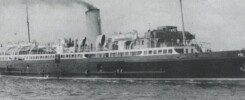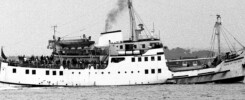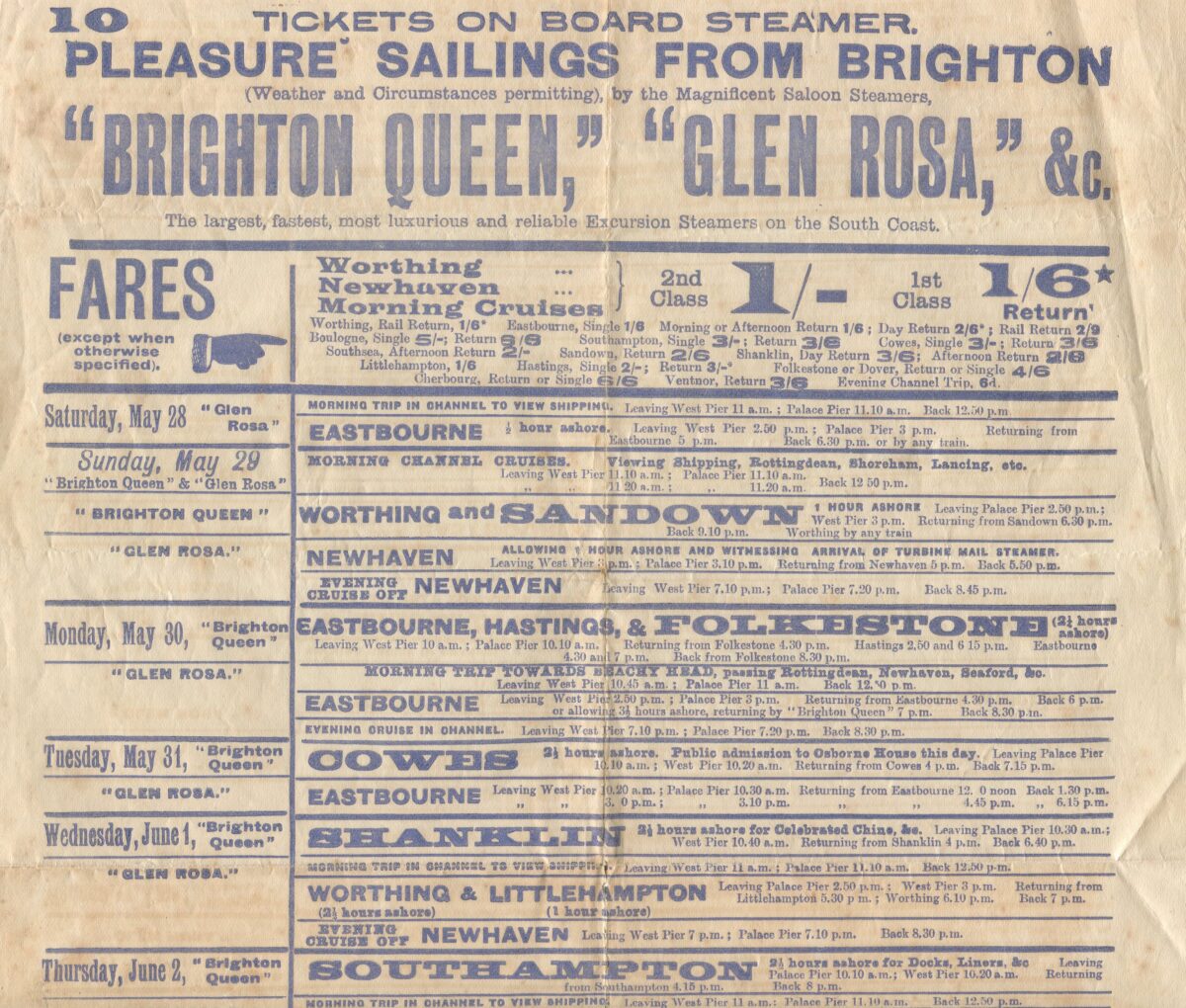
In late May and early June of 1910 P & A Campbell’s steamer trips from the Sussex Coast piers at Brighton, Eastbourne and Hastings were in the hands of their Brighton Queen and Glen Rosa.
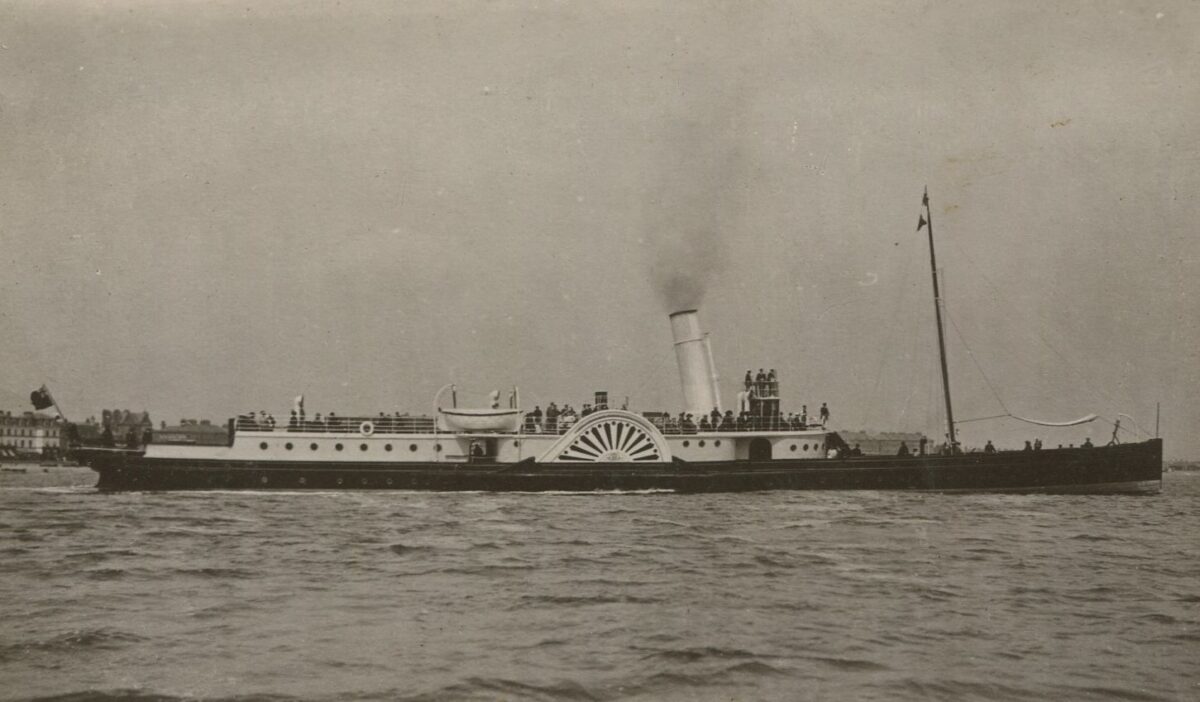
Glen Rosa was scheduled for the local morning, afternoon and evening trips linking Brighton, Eastbourne and Hastings including the “Channel Cruise viewing Shipping, Rottingdean, Shoreham, Lancing etc”; “Newhaven to witness the arrival of the Turbine Mail Steamer” (and remember that turbines were then at the cutting edge of technology); “To Beachy Head”; “To Worthing and off Littlehampton”; and so on.

Brighton Queen took the longer trips which this week included:
Sunday May 29th leaving Brighton’s Palace Pier at 2.50pm and the West Pier at 3pm for Worthing and Sandown Isle of Wight, returning at 6.30pm to arrive back in Brighton at 9.10pm where passengers for Worthing also disembarked to take the train home.
Monday May 30th from the West Pier at 10am and the Palace Pier at 10.10am for Eastbourne, Hastings and Folkestone with about two and a quarter hours ashore before departure at 4.30pm to be back in Brighton by 8.30pm.
Tuesday May 31st from the Palace Pier at 10.10am and the West Pier at 10.20am to Cowes with the option of visiting Osborne House which was open to the public on this day with return at 4pm due back in Brighton at 7.15pm.
Wednesday 1st June from the Palace Pier at 10.30am and the West Pier at 10.40am for Shanklin Isle of Wight for two and a half hours ashore and view of the “Celebrated Chine”. Return was at 4pm due back 6.40pm.
Thursday 2nd June from the Palace Pier at 10.10am and the West Pier at 10.40am to view the docks and the liners with two and a half hours ashore at Southampton. Return was at 4.15pm due back at Brighton 8pm.
Friday 3rd June from the Palace Pier at 10.30am and the West Pier at 10.40am for Ventnor, Isle of Wight for two and a half hours ashore “for the celebrated Undercliff”.
Saturday 4th June from the Palace Pier at 2.50pm and the West Pier at 3pm for Shanklin, Isle of Wight allowing one hour ashore with return at 6.45pm due back 9.40pm.
Sunday 5th June from the Palace Pier at 9am and the West Pier at 9.10am for two and a half hours ashore in Cherbourg “By Request” to view “The Celebrated Dockyard, Town and Arsenal, Immense Breakwaters, Fortifications, Warships, Magnificent Casino etc. Chars-a-banc meet the Steamer and convey passengers to places of interest in Cherbourg and the neighbourhood at a charge of 1/- each”.
Monday 6th June from the West Pier at 10am and the Palace Pier at 10.10am for Eastbourne, Hastings and Dover for 2 hours ashore with return at 4.30pm for Hastings 6.30pm, Eastbourne 7.30pm and Brighton 9pm.
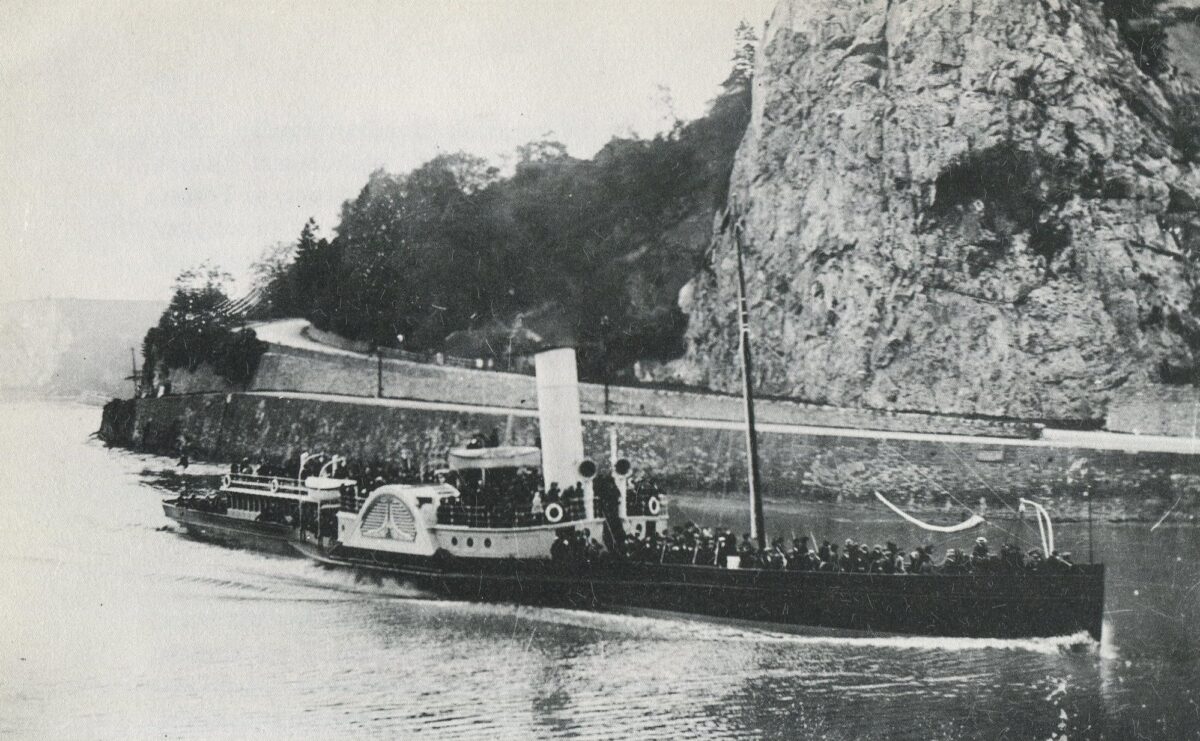
In the peak weeks of 1910 they were joined by the Bonnie Doon which allowed one of the steamers to concentrate on local trips from Hastings and Eastbourne, one for local trips from Brighton and Eastbourne and the third, Brighton Queen, to continue to offer the day trips further afield.
This steamer notice describes the fleet as “The largest, fastest, mort luxurious and reliable excursion steamers on the South Coast”. It is hard to disagree with most of that although we must remember that the Sussex Coast piers are very exposed to winds from the east through south to the west and therefore were ever been prone to cancellations when the wind blew.
As the railways expanded from the 1830s onwards they offered the opportunity for all the social classes to travel to the seaside. That led to the expansion of steamer services from the newly built piers to take advantage of this burgeoning demand at the resorts. And as the 1870s moved through the 1880s into the 1890s and the turn of the century excursion paddle steamers got bigger, were better equipped and provided higher standards of amenity than their more spartan predecessors. And P & A Campbell was a driving force for that.
The Belle Epoque period of Edwardian Britain in the run up to the First World War was the apotheosis of paddle steamer excursions in the UK. Never before was there, nor has there been since, such an array of trip options available nationwide. Indeed if you had studied the steamer notices assiduously and picked your dates you could have travelled from Great Yarmouth to Plymouth entirely by paddle steamer changing along the way and booking hotels for overnight stays at, say, Southend, Ramsgate, Folkestone, Brighton, Southampton, Bournemouth, Weymouth and Torquay. Heaven on a stick really for any who love the pleasure of being board paddle steamers for extended periods.
However there were many who preferred the shorter and therefore more affordable trips over these long distance marathons. E C B Thornton records in his excellent book “South Coast Pleasure Steamers”, which was my childhood bible, that of all “the variety of trips available to the excursionist the most popular were probably the cross-channel trips to Boulogne or Cherbourg”. Much as I respect him and love his books, I disagree with him on that. Yes those trips did have a popularity and were doubtless packed when the going was good with those who could afford to go on them but the numbers of passengers permitted on cross channel trips by the Board of Trade were ever lower than those on coastal voyages which themselves were lower than on Partially Smooth Waters on estuaries which were again lower than on Smooth Waters on rivers. So the fares to go foreign were proportionately much more expensive than for any other trips and therefore put up a real barrier to the vast market segments of those on more modest incomes.
In 1910 the average annual wage was around £70. This scales down to £1 7s a week. The Brighton Queen’s Cherbourg sailing in this week was priced at 6/6 per head. That is pretty much a quarter, and for a couple half, of the average weekly wage of the time. The average weekly wage today is around £600. A quarter of that is £150 and a half £300. That’s a lot of money to fork out on a day trip if you are not that well off.
It is therefore not altogether surprising to find that here on the Sussex Coast in 1910, as in other years, in the peak weeks P & A Campbell rostered two paddle steamers for the local morning, afternoon and evening trips with their more affordable fares for the one they advertised for the dearer and longer day trips.
For me, looking back, I think that this was one of the great strengths of the commercial planning of the companies in the heyday of paddle steamer excursions. By offering different things to different market segments at different prices they were able to provide something, somewhere, somehow to all the social classes from the moneyed elite through to those constrained by a very tight budget but not necessarily on the same paddle steamer, or the same trip, at the same time.
Tiny Point of Detail:
P & A Campbell owned two different paddle steamers called Brighton Queen. There was this one built in 1897 for the Brighton, Worthing and Hove Steamship Company and acquired, along with the rest of the business, and largely rebuilt in 1902. She served the Sussex resorts for the remainder of her peacetime career before hitting a mine and sinking off the Belgian Coast on 5th October 1915 on war time service as a minesweeper.
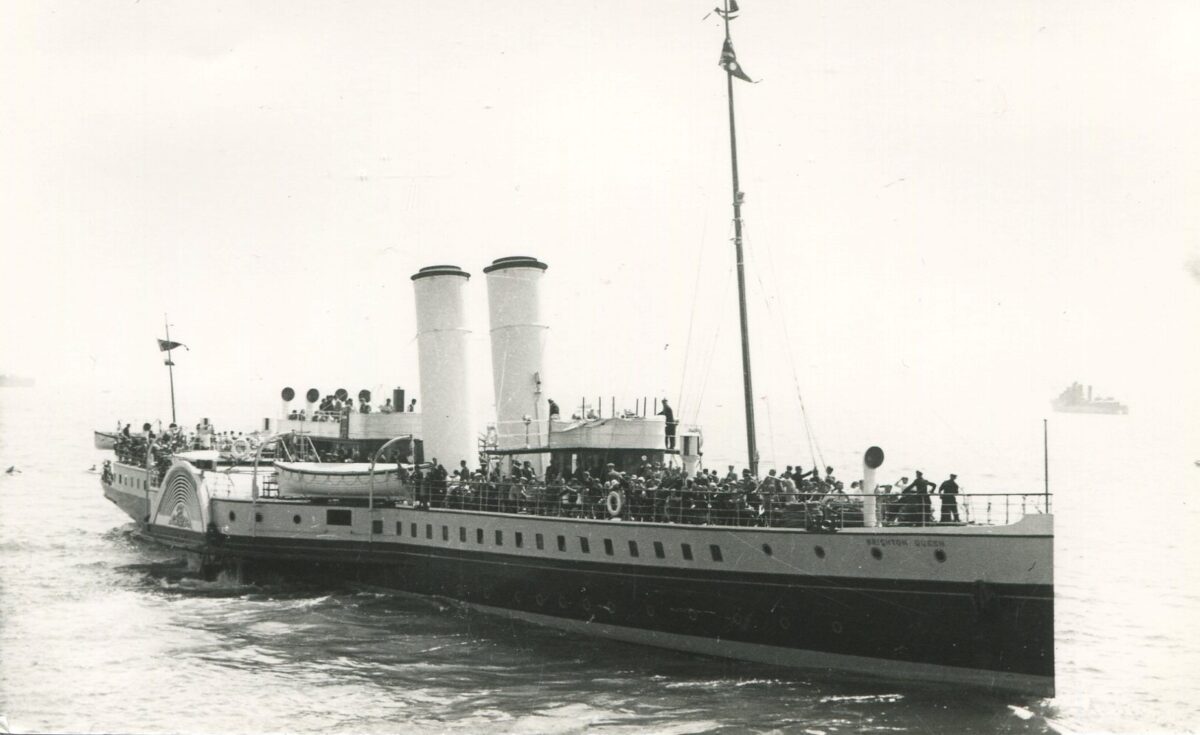
Then there was this one built as the Gwalia in 1905 for the Barry Railway Company’s Bristol Channel services. She passed to the Furness Railway Company in 1910 for their routes connecting Fleetwood, Morecombe and Barrow. After service in the First World War as a minesweeper she was bought to operate on the Bristol Channel as part of Tucker’s Yellow Funnel fleet. When that business failed she was acquired by P & A Campbell and continued to run on the Bristol Channel until 1932 after which she was renamed Brighton Queen and transferred to run on the Sussex Coast up to the outbreak of the Second World War. Taken over for use as a minesweeper she was sunk on 31st May 1940 whilst evacuating 700 troops from Dunkirk.
So perhaps there were some amongst this second Brighton Queen’s passengers during her Sussex Coast incarnation in the 1930s who remembered that balmy summer of 1910 when they had taken a trip from Brighton to Cowes with their families aboard a paddle steamer called Brighton Queen and mistakenly believed, all those years later, that they were travelling aboard the same boat.
Kingswear Castle returned to service in 2023 after the first part of a major rebuild which is designed to set her up for the next 25 years running on the River Dart. The Paddle Steamer Kingswear Castle Trust is now fund raising for the second phase of the rebuild. You can read more about the rebuilds and how you can help if you can here.
John Megoran

